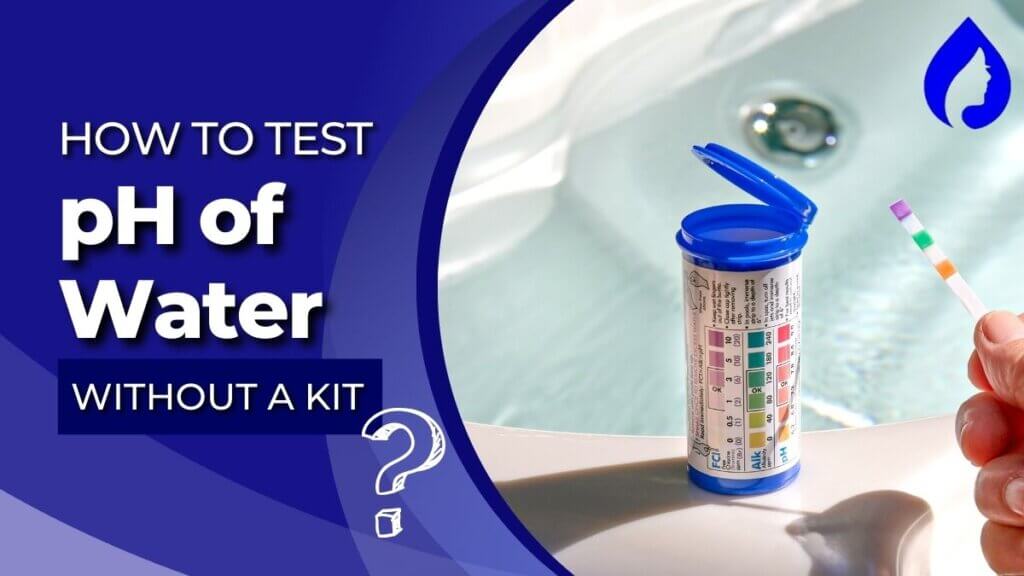
Can’t figure out how to test pH of water without a kit? I have good news for you.
You can check the pH level of water without a kit using simple DIY methods like pH strips, red cabbage, blueberries, and many more. Keep reading this article to find out how these methods work.
⭐How to Test Water pH Without Kit: 5 Easy DIY Methods
| Method | Time Required | Easiness | Effectiveness | Precautions |
| Red Cabbage | 2-5 Minutes | 8/10 | 9/10 | Be careful while boiling the cabbage in water |
| pH Strips | 1-3 Minutes | 10/10 | 9/10 | Needs to be stored in proper condition to avoid damage. |
| pH Meter | 1-3 Minutes | 10/10 | 10/10 | Since it is an electronic device, make sure the batteries are fresh and regularly changed. |
| Blueberries | 5-8 Minutes | 7/10 | 8/10 | Make sure to remove the pulp and preserve the fruit skin while making the indicator. |
| Litmus Paper | 1-2 Minutes | 9/10 | 8/10 | Store in a suitable place to avoid any damage to the paper causing inaccurate analysis. |
How To Test Your pH Level Without Strips Using A Digital pH Meter
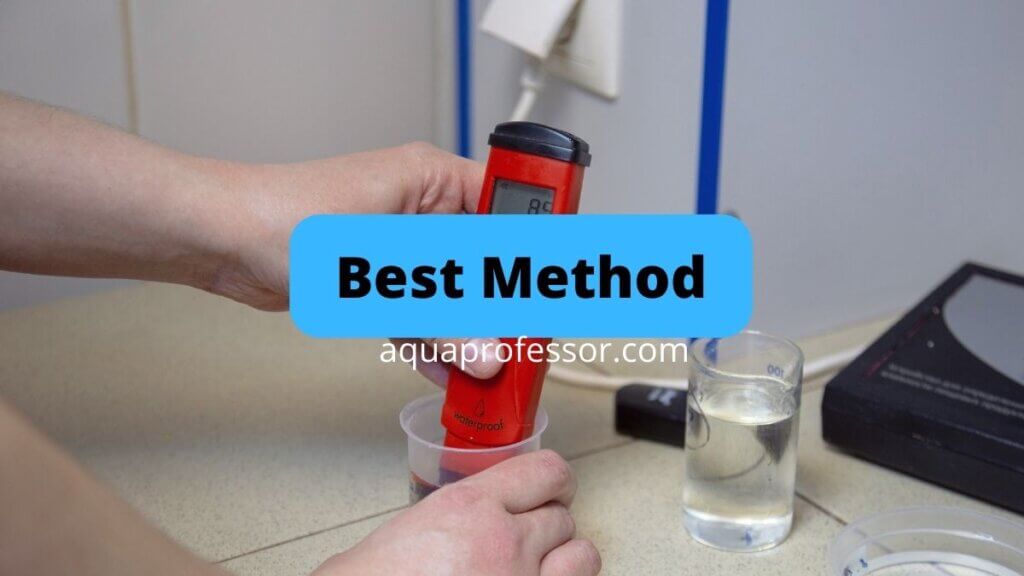
This electronic device can accurately measure the pH of your water and give you precise results about its acidity or alkalinity.
A pH meter is one of the best alternatives to a pH kit today. It comes with a glass electrode. To test the pH levels of water, dip the electrode in water, and wait for the results to be displayed on the meter.
A pH meter can also detect any contaminants in your water sample that may hinder the process of testing water. Make sure to rinse the glass electrode with clean water before proceeding with water testing.
A pH meter eliminates the chances of human error as it is fully digitalized. Moreover, it does not depend on color interpretation as it gives precise numeric values about the pH of your water.
When it comes to relative analysis based on color, the chances of human error are significant. For these reasons, a pH meter is indeed one of the best options available to you as a DIY pH testing method.
Also Read: What is Water Softener Salt?
How To Test pH Of Water With pH Strips
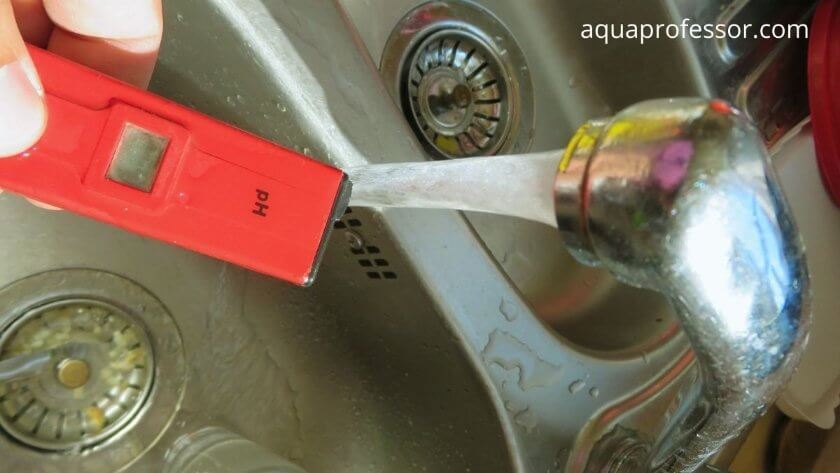
pH strips are available on the market, and you can get them at your nearest convenience store. pH strips are one of the easiest and most efficient ways of testing pH.
These pH strips come with a color chart. To test your water with a pH strip,
One thing you need to take care of with pH strips is storage. pH strips are prone to damage and hence require proper storage conditions. Also, ensure your analysis is accurate while matching the strip’s color with the manual, as it is easy to misinterpret results with a pH strip.
Limitations
The limitation with these strips is that they require certain storage conditions (as mentioned just now), which, when not met, may cause damage to the strips. The use of damaged or outdated strips will lead to inaccurate results.
Also Read: Is Acid In Well Water Harmful?
How To Check pH Of Water Using Litmus Paper
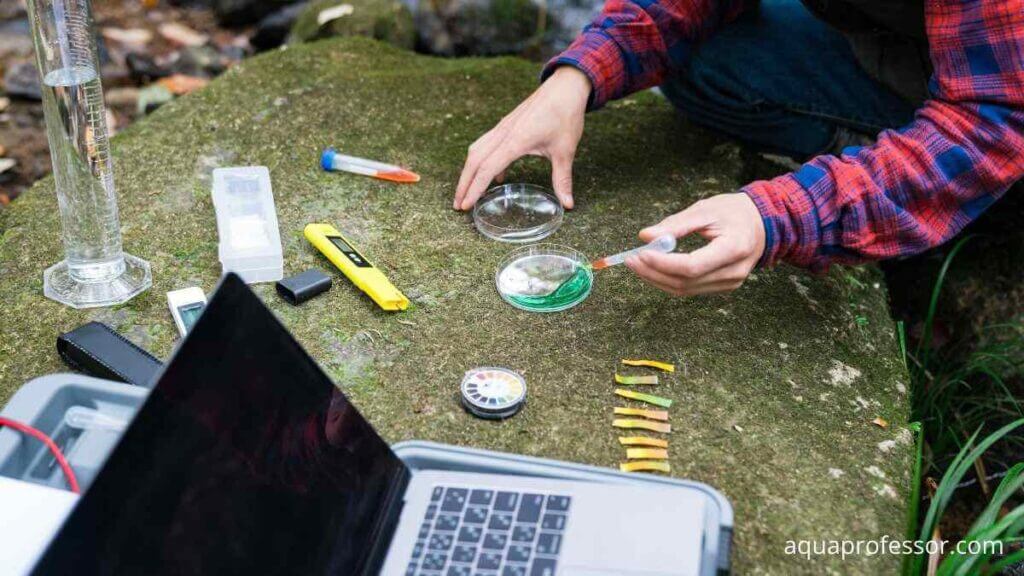
Litmus paper is like pH strips but with a small twist. They are small strips of paper indicating water’s acidity and alkalinity. You can easily buy litmus paper from your nearest convenience store.
Litmus paper also works by showing color in acidic and alkaline mediums. You will need to buy both kinds of litmus paper, red and blue, as each works in just one kind of medium.
The blue litmus paper turns red in the presence of an acidic solution. However, the basic medium has no color change in blue litmus. Similarly, in an alkaline medium, the red litmus turns blue. In an acidic medium, it has no color change.
Also, the litmus paper has no effective color change in a neutral solution.
The Litmus paper gives a good idea about the acidity or basicity of your water. Still, it is not as effective at giving precise results as the first two methods. The limitation of litmus paper is that it only provides you with an acidic or alkaline response.
Also Read: Is Alkaline Water Safe During Pregnancy?
How To Test Water pH Using Red Cabbage Juice Indicator

Red cabbage is an example of a natural indicator, i.e., things available in nature that act as indicators of acidity and basicity. To make a red cabbage pH indicator, follow the following steps:
To test the pH of your water with a red cabbage indicator, get the DIY red cabbage indicator in a clean container. Add a few drops of water that is to be tested.
Results
If the water has acidic particles, the indicator’s color will change to red or pink. If the water is neutral, the indicator will maintain its color. If the water is basic, the color of the cabbage water will turn blue or bluish-green.
Also Read: Iron Pro 2 Water Softeners Review
How To Test Water pH At Home Using Blueberries

Blueberries are another example of a natural indicator. The pigmentation in blueberries, i.e., the dark blue color, is because of a peonidin chemical. Peonidin is sensitive to acids and bases and may change color in its presence. Due to this characteristic, blueberries can be a good pH indicator.
Here’s how you can make an indicator out of blueberries:
Results:
Add this DIY indicator water to your water sample. If the sample is acidic, the indicator will lose its color and become less dark, turning into a faintly red color. The indicator will change into a darker color if the water sample is basic.
Also Read: Does Zerowater Filter Remove Flouride?
Which Is the Best Method Of Testing The pH Of Water At Home?
According to my research, the best way to test the pH of your water yourself is to use a pH meter. As mentioned earlier, a pH meter or a digital meter is an electronic device that accurately reads your water’s pH.
It not only tells you if your water is acidic or basic, but it also gives you information about the intensity of acidity or basicity of your water. This helps decide how much treatment it needs to get to the optimum range.
Moreover, unlike other indicators, it does not depend on the appearance of the color. It gives a more detailed analysis, along with minimizing the chance of human error to a great extent.
What Is the Optimum pH Level for Drinking Water?
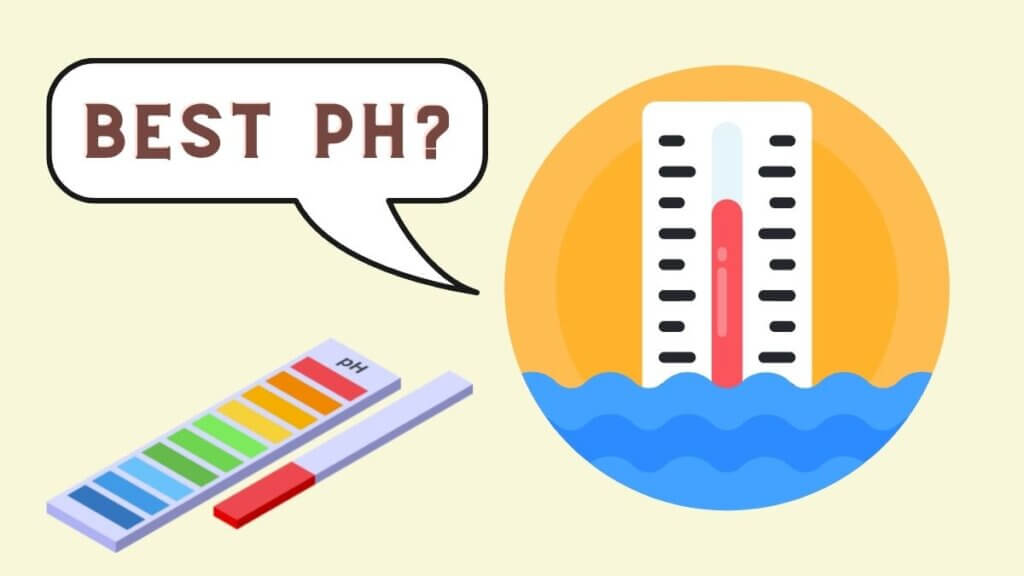
The water pH can range from 1 to 14, with that of pure water or unpolluted water being 7. A pH range between 1 and 7 is considered an acidic level, and from 7 to 14 is considered the alkaline level of water. I found in my research that drinking water that has a neutral pH (i.e., between 6.5-8.5) is best suited for consumption.
Water with an acidic pH, i.e., below 6.5, can be harmful. The problem with acidic water is that it may leach metals from pipelines and tanks and add to your water’s metal and impurity content.
Water with higher levels of metals like lead, manganese, copper, and iron can severely affect a person’s health. Hence, the consumption of acidic water is harmful to health.
On the other hand, water with an elevated pH, i.e., alkaline nature, is not as harmful to the human body as acidic water. Water with a pH of more than 8.5 does not pose much health risk to the one consuming it, but it may develop a bitter taste.
It can also lead to magnesium buildup in pipelines. There are chances that alkaline water may cause the skin to become dry and cause skin problems. If you or your family are facing skin problems, it may be because your water is alkaline in nature.
In conclusion:
Drinking water with a neutral pH ranging between 6.5 and 8.5 is best suited for consumption. While water with a lower pH may cause severe health issues, water with an elevated pH may not be as harmful.
When Does Drinking Water Become Acidic or Basic?
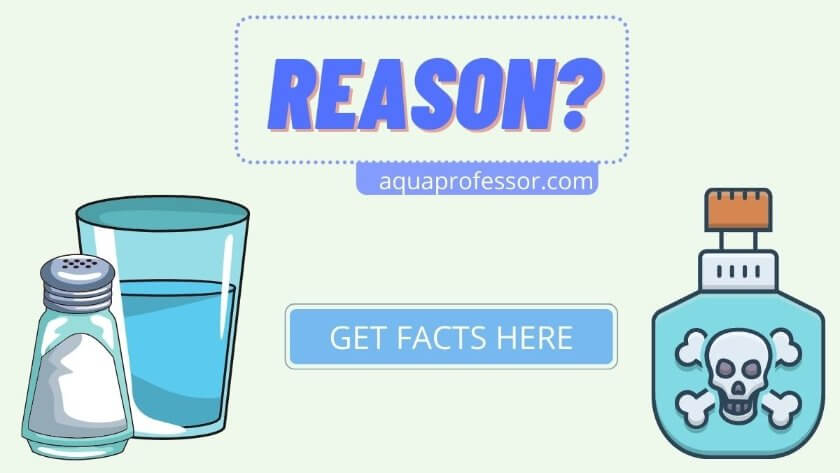
It is known that water with a pH ranging from 6.5 to 8.5 is considered neutral and safe for consumption. Any pH level higher or lower than this may be unsafe for consumption. Now the question arises, how does water become acidic or basic?
Here’s what causes the pH change in water:
Acidity In Water:
Acidity in water means the water pH level lies below 6.5, which can cause several health problems. One of the reasons behind acidic water is acid rain, which lowers the pH level of groundwater. Other reasons include soil microbes and rock formations generating acids, which get mixed with water and significantly lower their pH.
Urbanization and industrialization have also affected water quality. Industrial pollution is a significant cause of increased acidity in water. And so the water found near chemical industries, dumping sites for such industries, mining areas, etc., becomes highly acidic and unsuitable for consumption.
Acidic water may contain heavy metals, affect your teeth, cause poor bone health, and damage your house’s plumbing system, among many other ill effects. Hence, getting your water pH tested and treated is vital to maintaining healthy living.
Some ways in which you may be able to treat your acidic water and bring it up to a healthy neutral pH include treating it with an alkaline substance like baking soda or soda ash and installing a filtering system that will help bring the pH back up to its optimum neutral range.
Another alternative would be the use of water distillation systems.
Basicity In Water:
Unlike acidic water, alkaline water may not have severe health effects on the body. They may, however, have an unpleasant bitter taste and cause skin dryness when consumed.
The alkalinity of water is caused by chemicals such as carbonates, bicarbonates, or hydroxide compounds. When water interacts with sources rich in compounds like carbonates and bicarbonates, these chemical compounds are taken up by the water, causing elevated pH levels.
Apart from adding a bitter taste to water, the high pH of water can cause damage to pipelines and accelerate the equipment’s wear and tear rate.
Here’s an interesting fact:
Some claim that the consumption of alkaline water is good for your health. This claim, however, is difficult to believe. While alkali water may not cause any significant damage to health, it is recommended that one consume water with a pH falling in the neutral (6.5-8.5) range.
So, if your water pH comes out to be alkaline after testing, it is best to treat it with acidic substances like citruses and acetic acid and use filters to bring the pH of water back to the optimum range.
Also Read: How To Remove Iron From Well Water?
Is Acidic Water Better Than Alkaline?
No. Acidic water is more harmful for consumption than alkaline water. Acidic water causes the leaching of metals from pipelines and tanks.
These leached metals add to the metal content of water. Water with a high metal content can be toxic and harmful for consumption and cause several health risks.
On the other hand, alkaline water does not cause much trouble to the body when consumed. However, water with an elevated pH may have a bitter taste and cause some skin issues such as dryness. It is best to intake neutral pH water to avoid developing health issues.
If you think your water has lowered or elevated pH levels, get it tested as soon as possible and treat it accordingly.
How To Test pH Of Water Without A Kit FAQs

Why is water pH testing necessary?
It is essential to test the pH of the water to ensure the life depending on it does not get harmed. Human activities and aquatic life also thrive on an optimum pH range; hence, water pH must be regularly tested and checked in case of abnormalities.
What is the simplest way to neutralize high water pH?
The simplest way to lower water pH, i.e., neutralizing high water pH, is by adding natural and food acids like lemon and citric acid to your water. This may give your water a slight citrus taste, but the pH will be effectively lowered, and the water will be made safe for consumption.
Is water pH testing with a kit better?
While pH testing kits may be efficient in their functioning, there is another alternative that may be better than pH testing kits: pH meters. pH meters provide a more detailed and accurate analysis of the water pH levels.
What household items can be used to test water pH at home?
Household items like red cabbage, blueberries, turmeric, red onion, and soap scum can be used to test the pH of water, as all these products act as indicators and tell if the water is acidic, alkaline, or neutral.
Is it good to drink 9.5 pH water?
Water with a pH of 9.5 is basic. It is safe to consume but may taste bitter and cause skin problems. It is better to consume water with a neutral pH.
Sayan understands that access to clean water doesn’t have to be costly.
He strives to provide knowledge of water purification techniques in the simplest way possible so that we can lead a healthy life without breaking our bank.
